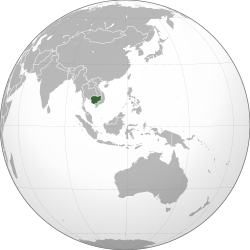Kingdom of Cambodia (1975–76)
| Kampuchea (1975–76) កម្ពុជា Kâmpŭchéa Democratic Kampuchea (1976–82) |
||||||||||||
| កម្ពុជាប្រជាធិបតេយ្យ Kâmpŭchéa Prâcheathippadey |
||||||||||||
|
||||||||||||
|
|
||||||||||||
|
Anthem Dap Prampi Mesa Chokchey ដប់ប្រាំពីរមេសាមហាជោគជ័យ "Great Victorious Seventeenth of April" |
||||||||||||
|
Location of Democratic Kampuchea
|
||||||||||||
| Capital | Phnom Penh | |||||||||||
| Languages | Khmer | |||||||||||
| Government | Unitary Maoist agrarian-socialist one-party totalitarian dictatorship | |||||||||||
| Communist Party General Secretary | ||||||||||||
| • | 1976–1979 | Pol Pot | ||||||||||
| President of the State Presidium | ||||||||||||
| • | 1975–1976 | Norodom Sihanouk | ||||||||||
| • | 1976–1979 | Khieu Samphan | ||||||||||
| Prime Minister | ||||||||||||
| • | 1976–1979 | Pol Pot | ||||||||||
| • | 1976 | Nuon Chea (interim) | ||||||||||
| Legislature | People's Representative Assembly | |||||||||||
| Historical era | Cold War | |||||||||||
| • | Fall of Phnom Penh | 17 April 1975 | ||||||||||
| • | Proclamation | 15 January 1976 | ||||||||||
| • | Vietnamese invasion | 5 January 1979 | ||||||||||
| • | Establishment of the CGDK | 22 June 1982 | ||||||||||
| Area | 181,035 km2 (69,898 sq mi) | |||||||||||
| Currency | None - currency was abolished. | |||||||||||
| Calling code | +855 | |||||||||||
|
||||||||||||
| Today part of |
|
|||||||||||
Kampuchea (Khmer: កម្ពុជា, Kâmpŭchéa), officially known as Democratic Kampuchea (DK; Khmer: កម្ពុជាប្រជាធិបតេយ្យ, Kâmpŭchéa Prâcheathippadey from 5 January 1976, was the name of the Khmer Rouge (KR)-controlled state that, between 1975 and 1979, existed in present-day Cambodia. It was founded when the Khmer Rouge forces defeated the Khmer Republic of Lon Nol in 1975. During its rule between 1975 and 1979, the state and its ruling Khmer Rouge regime was responsible for the deaths of millions of Cambodians through forced labour and genocide. After losing control of most of Cambodian territory to Vietnamese occupation, it survived as a rump state supported by China. In June 1982, the Khmer Rouge formed the Coalition Government of Democratic Kampuchea with two non-communist guerilla factions, which retained international recognition. The state was renamed Cambodia in 1990 in the run up to the UN-sponsored Paris Peace Agreement conference of 1991.
In 1970, Premier Lon Nol and the National Assembly deposed Norodom Sihanouk as the head of state. Sihanouk, opposing the new government, entered into an alliance with the Khmer Rouge against them. Taking advantage of Vietnamese occupation of eastern Cambodia, massive US carpet bombing ranging across the country, and Sihanouk's reputation, the Khmer Rouge were able to present themselves as a peace-oriented party in a coalition that represented the majority of the people. Thus, with large popular support in the countryside, the capital Phnom Penh finally fell on 17 April 1975 to the Khmer Rouge. The KR continued to use Sihanouk as a figurehead for the government until 2 April 1976 when Sihanouk resigned as head of state. Sihanouk remained under comfortable, but insecure, house arrest in Phnom Penh, until late in the war with Vietnam he departed for the United States where he made Democratic Kampuchea's case before the Security Council. He eventually relocated to China.
...
Wikipedia



